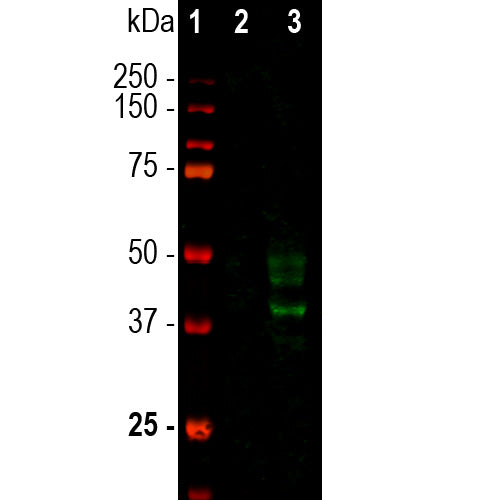

EnCor Biotechnology
Mouse Monoclonal Antibody to Doublecortin, Cat# MCA-3E1
Description
The MCA-3E1 antibody was made against full length recombinant human doublecortin expressed in and purified from E. coli. The antibody works well for western blotting and for IF, ICC and IHC (for IHC see data under "Additional Data" tab). Doublecortin, also knonw as DCX, is a microtubule associated protein which is expressed early in neuronal development.
- Cell Type Marker
- Cytoskeletal Marker
- Developmental Marker
- Immunohistochemistry Verified
- Mouse Monoclonal Antibodies
Add a short description for this tabbed section
| Immunogen: | Recombinant full length human Lis-A isoform of doublecortin expressed in and purified from E. coli. |
| HGNC Name: | DCX |
| UniProt: | O43602 |
| Molecular Weight: | 35-45kDa |
| Host: | Mouse |
| Isotype: | IgG2a |
| Species Cross-Reactivity: | Human, Rat, Mouse |
| RRID: | AB_2572262 |
| Format: | Protein G affinity purified antibody at 1mg/mL in 50% PBS, 50% glycerol plus 5mM NaN3 |
| Applications: | WB, IF/ICC, IHC |
| Recommended Dilutions: | WB: 1:1,000. IF/ICC, and IHC: 1:1,000. |
| Storage: | Store at 4°C for short term, for longer term store at -20°C. Stable for 12 months from date of receipt. |
Doublecortin was originally discovered since defects in the gene encoding it are causative of an X-linked lissencephaly, a rare group of brain malformations resulting in a smooth cerebral cortex caused by aberrant neuronal migration during development (1-4). The name doublecortin comes from the unusual layering of the cortex in this form of lissencephaly, which appears to have a second deep cortical layer of neurons. The doublecortin protein appears to function as a microtubule and actin binding protein expressed in developing neuroblasts as they become post-mitotic, but is lost as neurons mature. Loss of doublecortin causes defects in neuronal migration during development, so that many neurons fail to migrate into the cortex but remain close to the ventricular germinal zones. Antibodies to doublecortin are useful to identify neuronal stem cells and developing neurons in sections and in tissue culture, and to monitor neurogenesis. Studies of neuroblastoma, the most common form of extracranial solid tumor in childhood, show that levels of doublecortin mRNA are associated with poor patient outcome (5-7).

Chromogenic immunostaining of a 4% PFA fixed paraffin embedded rat testes section with mouse mAb to doublecortin, MCA-3E1, dilution 1:1,000, detected with DAB (brown) using the Vector Labs ImmPRESS method and reagents with citrate buffer retrieval. Hematoxylin (blue) was used as the counterstain. MCA-3E1 labels the Sertoli cells, the basement membrane and the late-stage spermatocytes. This antibody has not been tested in NBF fixed material. Mouse select image for larger view.
1. Ayanlaja AA. et a. Distinct Features of Doublecortin as a Marker of Neuronal Migration and Its Implications in Cancer Cell Mobility. Front. Mol. Neurosci. 10:199.
2. des Portes V, et al. A novel CNS gene required for neuronal migration and involved in X-linked subcortical laminar heterotopia and lissencephaly syndrome. Cell 92:51-61 (1998).
3. Gleeson JG, et al. Doublecortin, a brain-specific gene mutated in human X-linked lissencephaly and double cortex syndrome, encodes a putative signaling protein. Cell 92:63-72 (1998).
4. Jin J, et al. JNK phosphorylates Ser332 of doublecortin and regulates its function in neurite extension and neuronal migration. Dev. Neurobiol. 70:929-42 (2010).
5. Viprey VF, et al. Neuroblastoma mRNAs predict outcome in children with stage 4 neuroblastoma: a European HR-NBL1/SIOPEN study. J. Clin. Oncol. 32:1074-83 (2014).
6. Yanez Y. TH and DCX mRNAs in peripheral blood and bone marrow predict outcome in metastatic neuroblastoma patients.J. Cancer Res. Clin. Oncol. 142:573-80 (2016).
7. Rich JN, et al. Gene Expression Profiling and Genetic Markers in Glioblastoma Survival. Cancer Res. 65:4051-8 (2005).
Add a short description for this tabbed section





